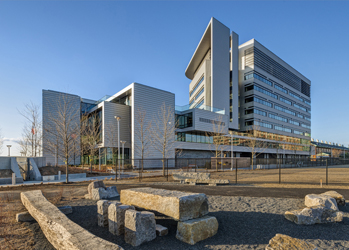Facility of the Month: Spaulding Rehabilitation Hospital
 CHARLESTOWN, Mass. — Two weeks after the Boston Marathon bombing, the Spaulding Rehabilitation Hospital opened just in time to care for victims. The 262,000-square-foot facility, set along Boston Harbor in Charlestown, gives patients a rehabilitative setting that is just the beginning of an urban revitalization on the waterfront.
CHARLESTOWN, Mass. — Two weeks after the Boston Marathon bombing, the Spaulding Rehabilitation Hospital opened just in time to care for victims. The 262,000-square-foot facility, set along Boston Harbor in Charlestown, gives patients a rehabilitative setting that is just the beginning of an urban revitalization on the waterfront.
Located on a redeveloped brownfield parcel in the Charlestown Navy Yard, the replacement hospital is divided into two connected sections: an eight-story patient tower and a three-story therapeutic gymnasium and pool. It was erected as a gathering place for the community and includes resilient and sustainable features.
“I think the choice of site for Spaulding was an inspired choice that wasn’t immediately evident. It’s inspired because the metaphor for rehabilitating an industrial brownfield is such a perfect metaphor for what rehabilitation medicine is. You take people who have been damaged by injury and bring them back into their life,” said Robin Guenther, FAIA, LEED AP, principal for Perkins + Will, the architect on the project with an office located in Boston.
Because rehabilitation medicine is traditionally done on a campus with a fair amount of natural surroundings, recreating the patient’s connection with nature was one of the bigger design challenges, Guenther said. “The challenge on a tight urban site is to provide the direct connection with the outdoors that gives people the range of experiences that they really need to move from an institutional setting back into the world,” she said. “The range of outdoor space that the design team was able to cull was a really great solution.”
The community connectivity was another major influence on the design because the Boston Redevelopment Authority placed some fairly strict community connectivity conditions on the site. The organization wanted to preserve the view shed from the street grid out to the water site, as well as required 75 percent of the ground floor to be accessible to the public across the site to the Boston Harborwalk. Spaulding used the requirements as a way to unlock a lot of program potential, making the hospital’s dining room and café, as well as public toilets, available to the public on the ground floor.
“[The Boston Redevelopment Authority] is trying to encourage development along the harborwalk that is accessible to the public and gives people amenities among the harborwalk,” Guenther said. “Spaulding really took advantage of that in a way and really delivered a really unique situation.”
This community-inspired environment makes it an ideal place for family members and friends to visit and help in the recovery process. The trail along the waterfront even features therapeutic equipment to encourage healing.
The design has this same inviting aspect with a glass curtainwall, which creates transparency and lots of natural light throughout the facility. On the building’s façade, gray materials were used to pay tribute to the site’s naval yard history, mimicking military battleships and aircraft carriers docked at the site during much of the 20th century.
Perhaps the most innovative part of the project is its attention to resilience. With natural disasters such as Hurricane Katrina and Hurricane Sandy continuing to raise concern, Spaulding wanted a building that would account for the rise in sea level and have energy efficient features.
To accommodate future flooding, the project team raised the main floor by one foot and placed all of the HVAC equipment and infrastructure on the roof. The gymnasiums, multipurpose rooms and educational rooms have natural ventilation due to the installation of automatic operable windows, which also allow the building to remain operational when mechanical systems aren’t working.
Guenther noted that operable windows are also in the patient rooms for emergency reasons but also as a sustainability feature to “test operable windows because there’s a lot of concern about infection control in more medical settings, so the larger partners set up an experiment at Spaulding so they can measure in a set of controlled rooms what happens if you open the windows, and they’re hoping that they can learn from that some lessons that they can use on their other buildings.”
Vegetated roofs that mitigate water runoff, therapeutic terraces and gardens are also contributors to the project’s achieved LEED Gold certification.
